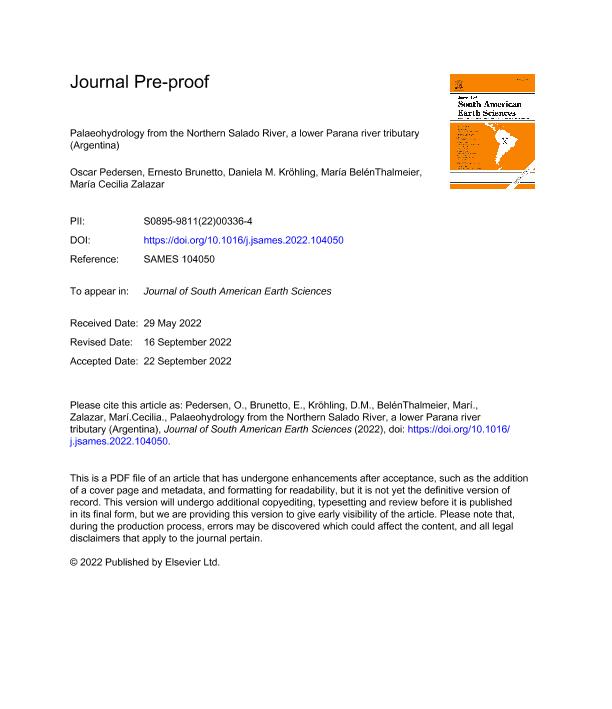Mostrar el registro sencillo del ítem
dc.contributor.author
Pedersen, Oscar Ariel

dc.contributor.author
Brunetto, Ernesto

dc.contributor.author
Krohling, Daniela Mariel Ines

dc.contributor.author
Thalmeier, Maria Belen

dc.contributor.author
Zalazar, Maria Cecilia

dc.date.available
2023-08-10T11:18:16Z
dc.date.issued
2022-09
dc.identifier.citation
Pedersen, Oscar Ariel; Brunetto, Ernesto; Krohling, Daniela Mariel Ines; Thalmeier, Maria Belen; Zalazar, Maria Cecilia; Palaeohydrology from the Northern Salado River, a lower Parana river tributary (Argentina); Pergamon-Elsevier Science Ltd; Journal of South American Earth Sciences; 120; 9-2022; 1-44
dc.identifier.issn
0895-9811
dc.identifier.uri
http://hdl.handle.net/11336/207700
dc.description.abstract
Palaeofloods and drainage palaeostage can be approached from sedimentological, stratigraphical, geomorphological, geodetic, and geophysical information. This allows us to supply pre-instrumental and historical data and to assess a particular flood-prone area. It has been proved that the study of Late Holocene fluvial sediments is valuable source to estimate 1 × 102-1x103yr. scale occurrence and long-term recurrence of maximum events. The geological evidence of palaeofloods in lowlands in Central Argentina may reveal higher discharges likely occurred in the near past. In this work, we attempt to identify sedimentological evidence of past floods in Late Holocene sediments from the northern Salado River (NSR), an important tributary of the lower Paraná River basin (Chaco-Pampean plain region). In the yr. 2003, the lower reaches of the NSR recorded an extreme flood event that provoked a disaster in Santa Fe, a city of 500,000 inhabitants located at the river mouth. Considering the importance of this event, we developed a geomorphometry methodology for discriminating different levels of fluvial terraces and flood indicators in a representative area of the NSR, using multi-scale resolution Digital Elevation Model (DEM) data. Descriptions of flood-associated fluvial landforms and sedimentological stratigraphic attributes were performed in the field. High-resolution geodetic information and digital optical images were obtained from UAV photogrammetry. Ground Penetrating Radar (GPR) cross-sections were achieved and addressed to detect extreme flood evidence. A geomorphometric routine was applied to simulate the extreme flood scenarios, based on the data obtained from the field. The map resulting from the simulation was compared to satellite images recorded in the yr. 2003 extreme flood. A series of slackwater deposits and other palaeostage indicators (SWD-PSI) showed elevations higher than those reached over the yr. 2003 extraordinary flood (instrumentally recorded) and in the yr. 1914 historic flood event. The geomorphometric simulation of a flood event, calibrated from these diagnostic landforms, allowed us to extend the flood-prone area beyond the boundaries of the current active floodplain and channel. The integrative methodology enabled the mapping of areas potentially prone to flooding. The estimations of the discharges associated to the inferred palaeofloods could be 50–80% larger than the maximum events historically documented and instrumentally measured.
dc.format
application/pdf
dc.language.iso
eng
dc.publisher
Pergamon-Elsevier Science Ltd

dc.rights
info:eu-repo/semantics/openAccess
dc.rights.uri
https://creativecommons.org/licenses/by-nc-sa/2.5/ar/
dc.subject
GEOMORPHOMETRY OF TERRACES
dc.subject
GROUND PENETRATING RADAR
dc.subject
LATE HOLOCENE SEQUENCE STRATIGRAPHY
dc.subject
PALAEOFLOODS
dc.subject
UAV GEODETIC PALAEOHYDROLOGICAL RECONSTRUCTIONS
dc.subject.classification
Geología

dc.subject.classification
Ciencias de la Tierra y relacionadas con el Medio Ambiente

dc.subject.classification
CIENCIAS NATURALES Y EXACTAS

dc.title
Palaeohydrology from the Northern Salado River, a lower Parana river tributary (Argentina)
dc.type
info:eu-repo/semantics/article
dc.type
info:ar-repo/semantics/artículo
dc.type
info:eu-repo/semantics/publishedVersion
dc.date.updated
2023-07-06T22:30:10Z
dc.journal.volume
120
dc.journal.pagination
1-44
dc.journal.pais
Estados Unidos

dc.description.fil
Fil: Pedersen, Oscar Ariel. Provincia de Entre Ríos. Centro de Investigaciones Científicas y Transferencia de Tecnología a la Producción. Universidad Autónoma de Entre Ríos. Centro de Investigaciones Científicas y Transferencia de Tecnología a la Producción. Consejo Nacional de Investigaciones Científicas y Técnicas. Centro Científico Tecnológico Conicet - Santa Fe. Centro de Investigaciones Científicas y Transferencia de Tecnología a la Producción; Argentina
dc.description.fil
Fil: Brunetto, Ernesto. Provincia de Entre Ríos. Centro de Investigaciones Científicas y Transferencia de Tecnología a la Producción. Universidad Autónoma de Entre Ríos. Centro de Investigaciones Científicas y Transferencia de Tecnología a la Producción. Consejo Nacional de Investigaciones Científicas y Técnicas. Centro Científico Tecnológico Conicet - Santa Fe. Centro de Investigaciones Científicas y Transferencia de Tecnología a la Producción; Argentina
dc.description.fil
Fil: Krohling, Daniela Mariel Ines. Consejo Nacional de Investigaciones Científicas y Técnicas; Argentina. Universidad Nacional del Litoral; Argentina
dc.description.fil
Fil: Thalmeier, Maria Belen. Consejo Nacional de Investigaciones Científicas y Técnicas; Argentina. Universidad Autónoma de Entre Ríos; Argentina
dc.description.fil
Fil: Zalazar, Maria Cecilia. Universidad Autónoma de Entre Ríos; Argentina
dc.journal.title
Journal of South American Earth Sciences

dc.relation.alternativeid
info:eu-repo/semantics/altIdentifier/url/https://linkinghub.elsevier.com/retrieve/pii/S0895981122003364
dc.relation.alternativeid
info:eu-repo/semantics/altIdentifier/doi/http://dx.doi.org/10.1016/j.jsames.2022.104050
Archivos asociados
